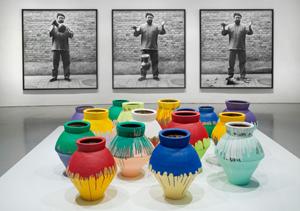Ai Weiwei at the Hirshhorn
By • January 27, 2014 0 1299

On May 12, 2008, an earthquake devastated the Sichuan province of central China, and more than 5,000 children lost their lives when the region’s shoddily constructed schoolhouses collapsed. After the catastrophe the state-controlled media tried to scuttle the incidents, detaining and threatening parents and volunteers who questioned the authorities and unfit building codes. Officials ordered the Chinese news media to stop reporting on school collapses, and parents were urged to accept money in exchange for their silence. Many of the schools were quickly reconstructed.
When Chinese artist Ai Weiwei visited the stricken region shortly after the earthquake, he saw the devastated schoolhouses, mounds of backpacks and twisted brambles of steel rebar scattered about the wreckage. The first thing he did was write about it in his blog (which had an extensive readership until Chinese authorities shut it down in 2009).
The next thing he did was to recruit volunteers through the Internet for his Citizens’ Investigation project, which compiled a list of the children who died in the earthquake. He gathered their names, birth years, genders and class, and displayed them along the walls of his Shanghai studio (now demolished) like a war memorial. At the Hirshhorn Museum, a replication of this wall faces the entrance to “Ai Weiwei: According To What?” a retrospective of the artist’s work, through February 24.
This wall is at once a statement of remembrance and protest, asking us with each name to confront the significance of an individual life and to weigh its loss, while defying his government’s mishandling and disregard of the situation. In all his work, Weiwei goes to great lengths to organize and document, to find a harmony in structure that reveals a feeling of truth in personal identity.
Weiwei’s work also has a way of confronting us with environments, filtering them through prismatic lenses and binding us all—his self, included—to the state of our modern times. Another piece in the exhibit brought about by the Sichuan earthquake events is a meticulously neat display of thousands of corroded steel rebar lengths laid out across the entire floor of a large gallery; the rebar was recovered in twisted heaps from the rubble of the schoolhouses, and the artist hired craftsmen to straighten them back out.
Consumed with the appropriating and rearranging of historical backgrounds and life experiences, Weiwei strives through his work to maintain a sincere, deeply rooted relationship with his surroundings, which is difficult when born into an upended society. Raised amidst the Chinese Cultural Revolution in the 1960s and 70s, Weiwei’s family was among the many antisocialists exiled to northwest China. Eventually returning to Beijing, Weiwei entered film school before moving to the US in 1981, where he studied at the Parsons School of Design in New York and documented his daily experiences with photographs, hundreds of which are woven through “According To What?”
This personal visual record traces his early search for identity, which would soon consume him in an altogether different way. After his return to China in 1993, all remnants of his past had been wiped out by development, and a sense of excavating has emerged in his work as he uncovers and readapts lost artifacts of his cultural heritage.
“Kippe” is a perfect brick of tightly stacked scrap wood, nearly six feet tall, made out of dismantled pieces of Qing Dynasty temples and framed within a set of gymnast’s parallel bars, a ubiquitous schoolyard amusement from Weiwei’s childhood. “Colored Vases” is a collection of 16 Han Dynasty vessels, ranging in age between 206 BCE – 220 CE, which Weiwei dipped in neon hues of industrial paint; the only remnants of their original ornate patterns gasp through streaks of Kermit-the-frog green and frosted periwinkle.
All of Weiwei’s physical artworks—which exclude his trail of viral and online photojournalism, conceptual projects, architecture, writings and his prolific Twitter account—have the gravity and permanence of monuments. They defy China’s cultural patterns of paving over pasts and intentional forgetting, as with the Sichuan earthquake. Weiwei decries his country’s push toward cultural uniformity with the grit and snarl of egoistic proclamations, dealing directly and often abrasively with the values of free speech and expression (as evidenced by photographs documenting his unique employment of a certain four-letter word at the site of various Chinese and US landmarks).
Weiwei was initially acclaimed by his government and awarded the opportunity to work on significant projects in his country (including designing the Olympic Bird’s Nest stadium from the 2008 Chinese Olympics). But since 2009, as a result of his heated political activism, the Chinese authorities have shut down his blog, detained him, kept him under house arrest, beaten him, confiscated his passport and demolished his studio.
There really is no clean end to this story. Weiwei is currently embroiled in murky charges of tax evasion by the Chinese authorities, and he is forbidden to leave the country for alleged suspicion of this and other crimes, from pornography to money laundering. He is currently working to prove his innocence.
But even ignoring all of this, Ai Weiwei is still a landmark contemporary artist. He distills monumental issues of our era by engaging the perspective of the individual, without losing focus on larger, more challenging implications. He stays aware of an ever-broadening network of global affairs, and uses an extensive web of media to empower his audience to understand and question their surroundings. And in an age where a government can all but cover up the deaths of 5,000 children, that means something.

